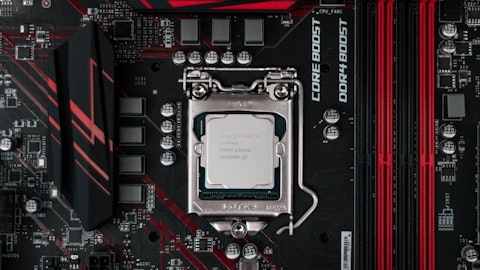Toshiya Hari: Thank you. And then maybe as a quick follow-up on HBM for Sanjay. You know, three months ago, you guys talked about or at least hinted that in fiscal ’24, you might be able to generate you know several $100 million in revenue. Is that sort of target still intact? Have things improved since then and I guess at what point do you expect your presence in HBM to be similar to your presence in DRAM overall? Thank you.
Sanjay Mehrotra: We are very excited with our HBM product. It is an industry-leading product with respect to performance, power, capacity, capability. And as we have mentioned, this product is in the qualification stages with our customers here and we expect revenue to begin in early 2024. And yes, we are very much still on track for meaningful revenue, several hundred million dollars in our fiscal year ’24. So pleased with the progress, continuing to make good progress. It is an exciting opportunity for the memory industry and Micron will be well-positioned to capture the generative AI opportunities that require the kind of attributes that our HBM3E memory brings to the market. And, of course, as we proceed through the fiscal year, we expect to be gaining share in this important part of the high – in this important high growth part of the memory market.
Toshiya Hari: Thanks so much.
Operator: Thank you. One moment for our next question. And our next question comes from the line of Timothy Arcuri from UBS. Your question, please.
Timothy Arcuri: Thanks a lot, Mark, I wanted to clarify the statement on gross margin. So, you had said in the prepared remarks that it would be positive in the back half of the fiscal year. But in response to the question just before, you said that it will be positive through fiscal ’24. So since you’re guiding negative in fiscal Q1, does that tell us that fiscal Q2 gross margin will be positive?
Mark Murphy: Good question, Tim. I didn’t comment on fiscal Q2. I – fiscal Q3, we believe, will be positive. And there’ll be a trend of improving gross margin fiscal Q1 through fiscal Q3.
Timothy Arcuri: Okay. So you don’t want to state that fiscal Q2 will be positive, maybe it will be, maybe it won’t.
Mark Murphy: It – maybe. It depends on of course pricing and we’re continuing to drive productivity and we’ll just have to see at these profitability levels, mix and other things matter. I mean, we do have favorable mix of DRAM going into the first half. You know, we’re increasing DRAM relative to NAND in the first half of the year. So that helps. You know, we, pricing, the momentum is definitively positive. It’s just a case of you know we’re in a transition period, we did see you know, we kind of had to meet the market on some special deals here in the fourth quarter and you know those effects will continue in the first half, but you know we’re definitely seeing new deals being struck at higher prices and we certainly expect that to strengthen in the second-half.
Timothy Arcuri: Got it, thanks. And then as a follow-up, just on that comment you just made about called special deals and – that you, you know, struck in, you know, fiscal Q4. NAND demand, you’re more positive on NAND demand, but pricing was still as bad if not worse than at least I thought it would have been in – you know, side of fiscal Q4. So is – can you kind of foot that, is that maybe you offering some big deals on the NAND side, some you know customers coming in and being opportunistic and you offerings some big deals to move bits and maybe shore up your NAND share, but at the expense of price. Can you just walk through that force? Thanks.
Mark Murphy: Yes. I would say, Tim, that, you know, really NAND pricing was not – was basically in line with the downs that we saw in the third quarter. So, I would say that prices – the decrease had slowed and the price or the market was being the firm off. You know that – you know customers realize that this is a period that’s ending, the markets firming up, you know, and so, you know, there is also some mix effects in there. We do see price and NAND improving in the first quarter. It will be up actually in the first quarter. And so I think that’s all, I’d say, on price for NAND.
Timothy Arcuri: Thanks, Mark.
Operator: Thank you. One moment for our next question. Our next question comes from the line of Mehdi Hosseini from Susquehanna Financial Group. Your question, please.
Mehdi Hosseini: Yes, sir. Thank you for taking my question. Two follow-ups. I would like to better understand the dynamics of seasonality. You talked about the NAND bit shipment declining in the Q1 fiscal year and most of the growth coming from DRAM, but how should we think about seasonality impact in February quarter? And I have a follow-up.
Sanjay Mehrotra: So certainly, the typical seasonality will be in place. But just keep in mind that FQ4, we had a very strong sequential bit growth in the NAND business. And – I mean coming off that big sequential growth, we are just guiding to you know normalized level of overall shipments as part of FQ1 and overall, you know – and again, the content continues to increase across the end-market applications. And that will continue to drive increased demand growth for us as well.
Mehdi Hosseini: But would there be seasonality in February quarter?
Sanjay Mehrotra: Well, typical seasonality trends that exist in the consumer market would be there. But keep in mind that you know it all depends on the mix of the business as well for us. In terms of NAND, you know, in – it – maybe I have already guided to the trends. But overall when we look at the full-year basis, we would look at you know that calendar year ’24, NAND will be growing in line with the long-term CAGR or near the long-term CAGR and DRAM will be growing in terms of demand much ahead of the long-term CAGR as well and all of that will of course take into account the typical seasonality that occurs in the industry.
Mehdi Hosseini: Great, thanks for detail. And second question has to do with the puts and takes in reducing wafer starts. And I understand that more emphasis is on the trade mix. But as you – as I think about memory like, there is no trailing edge. And in that context as you think about bringing utilization rate back up to the normal level. and some of the trailing edge converted to the leading edge, could that help with a bigger step-up in gross margin improvement? How should we think about it, assuming that the trailing edge would be phased out?
Sanjay Mehrotra: Well, good question and I think I would like to take the opportunity to provide some context here and overall background. As you know that in 2023, the industry has experienced extreme over supply and you know extreme negative effect on the profitability as well. And you see now that CapEx cuts and underutilization in the fab have been implemented across the industry given the CapEx constraints that we have, as well as given the poor profitability and certainly Micron has done that, but this is happening across the industry as well. And at the same time, the demand for the new products is increasing that requires, you know, as you were pointing out, leading edge technology as well. And in order to maintain our supply discipline and to meet the demand for these new products such as HBM, such as DDR5, we are shifting some of our equipment from older nodes into the newer technologies to ramp up those newer technologies into production.





